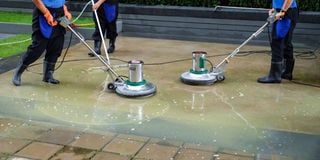How to choose a tile floor scrubber

A wider machine will reduce cleaning time, potentially lowering labour costs over time. PHOTO/shutterstock.com.
What you need to know:
Evaluate these factors based on your specific cleaning requirements. By selecting a floor scrubber tailored to your specific space and cleaning needs, you can enhance efficiency and reduce operational costs effectively.
Wish you could spend less time cleaning floors and more time enjoying life? Thanks to advanced technology, you can now invest in a floor scrubber that will reduce the effort and time required to keep your floors clean. However, choosing a floor scrubber is overwhelming because of the many choices available. Here is a step-by-step guide to help you choose the perfect floor scrubber for your needs.
Type of floor
There are two main types of floor scrubbing machines to consider, each suited for different floor types. Rotary brush/disc autoscrubbers are the most common, featuring one to three flat, round brushes or pad drivers. They offer versatility across various surfaces such as vinyl, concrete, terrazzo, ceramic tiles, rubber, granite, marble, and more.
If your floors are relatively smooth and flat, a rotary brush autoscrubber is an excellent choice. On the other hand, cylindrical brush scrubbers, also known as roller brush scrubbers, use a rolling action that effectively reaches into textured floor surfaces.
This makes them ideal for cleaning non-slip floors and other surfaces with pronounced textures. To determine the best option for your needs, especially if you have a combination of smooth and textured floors, it is advisable to schedule demonstrations for both types of machines. This hands-on approach will allow you to assess their performance and decide which type works most effectively for your specific cleaning requirements.
Size
When determining the ideal size of a floor scrubber, start by assessing the dimensions of the areas it will clean. Measure the narrowest doorway or passage through which the scrubber needs to fit, as this will dictate the maximum width of the machine you can purchase without needing to remove the floor squeegee frequently.
Additionally, consider the layout of the space and the number of obstacles present. Are you cleaning a spacious school gymnasium with few obstructions, or navigating around tables and chairs in a cafeteria? Do you need to clean in tight spaces such as restroom areas? Calculate the total square meters of floor area requiring cleaning.
Opt for a floor scrubber with the widest scrubbing width feasible within your budget, ensuring it remains maneuverable enough for smaller spaces.
A wider machine will reduce cleaning time, potentially lowering labor costs over time. Investing a bit more initially for a 62cm wide machine compared to a 46cm or 50cm one is likely to yield savings with each cleaning session.
By selecting a floor scrubber tailored to your specific space and cleaning needs, you can enhance efficiency and reduce operational costs effectively.
Maintenance
Ensuring a floor scrubber is easy to maintain is crucial for minimising breakdowns and reducing overall ownership costs. Key maintenance considerations include the accessibility of scrubbing brushes or pads, which are essential components for daily cleaning tasks.
Operators should be able to easily remove and reattach these components as needed. It is also important to assess how accessible the underside of the scrubber area is for maintenance.
For machines equipped with a floor squeegee, regular maintenance is necessary, typically requiring cleaning at the end of each shift and occasional removal. Evaluate how straightforward it is to remove and reinstall the squeegee. Some models may involve unscrewing knobs or bolts, while others allow for tool-free removal and installation. When evaluating brushes, check if there are wear indicators to notify operators when it’s time for replacement. Certain brands incorporate built-in wear indicators into their brushes, simplifying maintenance scheduling. Lastly, consider the ease of accessing and checking the vacuum hose, as this component also requires regular inspection. A design that facilitates easy removal of the vacuum hose supports efficient daily checks and maintenance routines.
Battery or electric?
When choosing between battery-powered and electric (cable-powered) floor cleaning machines, there are important considerations to weigh for each option. Battery-powered scrubbers offer significant advantages in terms of mobility and freedom of movement. They eliminate the safety hazard of trailing cords and enhance cleaning productivity by allowing operators to move more freely. However, the main drawback of battery-powered autoscrubbers is their higher initial cost compared to electric models. It’s worth noting that operating costs for electric scrubbers may also increase due to labor associated with changing power outlets during cleaning.
For smaller areas within close proximity (typically within 15-20 metres of an electrical socket), an electric scrubber may be suitable and cost-effective. These models often have cables of sufficient length to cover these areas efficiently.
On the other hand, if you need to clean larger spaces such as long corridors or areas with furniture and corners to maneuver around, a battery-powered scrubber is more practical. Electric scrubbers can become cumbersome and impractical in such scenarios, affecting productivity and ease of use.
If budget allows, opting for a battery-powered machine is generally recommended for its operational flexibility and efficiency, especially in larger cleaning environments. The initial investment in a battery-powered scrubber can lead to improved operational efficiency and safety, making it a worthwhile consideration for facilities with extensive cleaning needs.
Power
Your floor scrubber should have sufficient runtime to clean your entire area without needing to recharge. Calculate the True Theoretical Cleaning Performance (TCP) of the machine, which is often listed in user manuals based on ideal conditions of cleaning straight lines at four or five km/h. In reality, operational speeds are typically slower due to obstacles and maneuverability constraints in most environments.
Some scrubbers feature interchangeable fast-charging lithium-ion batteries, similar to those used in battery drills. They offer the option to have one set of batteries charging while using another set for cleaning, allowing for continuous operation if needed.




